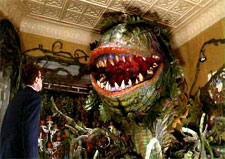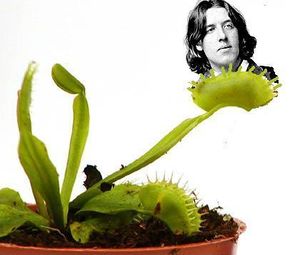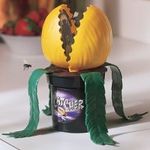Venus flytrap
“It's a trap!”
– Admiral Ackbar on Venus Flytraps
The Venus Flytrap (Dionaea itchybum) is a carnivorous plant found in the meteorite-spotted Carolina Bays or North America. The Venus Flytrap is so named because it actually originated on the planet Venus, and was carried to Earth on a meteorite approximately 500,000 years ago during the last Venusian crustal upheaval.[1]
Studies by the University of Studies that Mean Nothing have conclusively proven that the Venus Fly Trap is unrelated genetically to all other plant species on the planet, although it is sometimes grouped with other carnivorous plants to keep the books tidy.
Description[edit | edit source]
The Venus Flytrap is a large man eating monster. Each leaf reaches a maximum size of about three to seven meters, depending on the time of year; longer leaves with robust traps are generally formed after swallowing someone. Flytraps that appear to have more than 10 leaves are generally colonies, formed by by aliens underneath the ground. The common name "Flytrap" actually has nothing to do with the plant's prey, but rather one of the plant's more ingenious adaptations. Venus Flytraps are able to fly by manipulating the earth's gravitational field. After careful study, it was found that flytraps extract iron from haemoglobin, which their symbiotic aliens then magnetize. The iron is then stored in their teeth to provide both structural rigidity and the mechanism of flight. Venus flytraps can fly faster than the speed of sound. Hence, many inexplicable airplane crashes can be explained by hungry Venus Flytraps.
The leaf blade is divided into two regions: a flat, man eating part and a pair of terminal lobes, designed to release acids to digest human flesh. The upper surface of these lobes contains red bits and its edges secrete acids and feces. The lobes exhibit rapid movements, snapping shut when stimulated by flailing humans. The trapping mechanism is so specialized that it can distinguish between living humans and dead humans. This is because morgue owners in the 1800's used them to dispose of bodies as this was cheaper than cremation. Some third world nations still use Venus flytraps instead of cremation even to this day.
If the human is too small (babies are particularly bad for this) and escapes, the trap will reopen within 12 hours. If the prey moves around in the trap, it tightens and digestion begins more quickly.
Speed of closing can vary depending on the amount of meat and size the prey is. The speed with which traps close can be used as an indicator of a plant's general evilness. Venus Flytraps are not as humidity dependent as are some other mass killers such as that terror-war waging president and that Saddam bloke. Venus flytraps dislike music and if they hear the sound of it, will immediately devour the nearest piece of meat.
Mechanism of trapping[edit | edit source]
The mechanism by which the trap snaps shut involves some big ass muscles, steriod abuse and generally massive ass chompers. If the human is unable to escape, it is unwise to stimulate the inner surface of the lobes as they get off on it and will start squirting liquids at you ... ick, gross! This causes a further growth response that forces the edges of the lobes together, eventually sealing the trap hermetically and digesting you into a pussy liquid ready for excretion. The trap then reopens, and is ready for killing again. Traps rarely catch more than fifty humans in their lifetime.
Habitat[edit | edit source]
On Earth, the Venus Flytrap is found in office buildings, schools and shopping malls but normally are found flying above the Amazon rainforest. They are rarely found in kindergarten or other places where small humans hang out as they aren't worth eating - not enough meat yet.[2] Generally, Earth is a very suitable habitat for flytraps.
On their home planet, venus flytraps emit the caustic gases that cause the rampant greenhouse effect and other hazardous conditions on Venus. Since there are no humans on Venus, the plants float in the planet's upper atmosphere in order to photosynthesize and obtain raw materials for carbohydrates. Young flytraps must use their leaves like wings, flapping to stay aloft until they get enough iron. They have special bladders for harboring their alien symbionts. The aliens filter mineral-rich dust out of the air. The plants also use the aliens for nutrient storage; when times are tough, venus flytraps will digest some of them. There are fewer venus flytraps in their natural environment than on Earth because of giant killer Venusian aphids and mealybugs that prey on them.
Cultivation[edit | edit source]
Venus Flytraps are very popular as cultivated plants and are often used for catching burglers and other unwanted people on your property. They are difficult to grow as they often eat their owners.
If for some reason a grower wishes to feed a flytrap, live humans longer than 1 m tall should be used. Healthy Venus flytraps will produce white flowers sometimes, however, many growers remove the flowering stem just to be a prick.
Diet[edit | edit source]
Venus Flytraps gain a significant portion of their nutritional needs by trapping and ingesting humans, Skittles, your mom, and kittens. Some have even been known to swallow cows, horses and guinea pigs. Unwary prey is attracted to the plant's wonderful aroma, which smells a bit like cinnamon raisin swirls. When they touch the plant, tiny hairs trigger electrical impulses which close the plant's powerful "jaws" around the victim. Studies have shown that it can take a Venus Fly Trap up to six years to completely digest a kitten, during which time the kitten grows into a somewhat angry cat. The long digestion period for kittens is believed to be due to the number of fur balls the Venus Flytrap needs to cough up. Humans and other noxious animals however usually digest within 2-3 weeks. They like to eat people that look like James May,the first ever person to be eaten by one was in 1066 he was called William the conqueror.
Super Traps[edit | edit source]
Larger variations of the Venus Fly Trap have been known to ingest entire villages of South Carolinians, thus increasing job openings in the area by as much as 75 percent. This was accurately portrayed in the documentary Little Shop of Horrors.[3]
References[edit | edit source]
- ↑ http://flytrapgrowing.info/how-did-the-venus-flytrap-get-its-name/ How did the Venus flytrap get it's name?
- ↑ http://flytrapgrowing.info/category/habitat/ Venus flytrap habitat
- ↑ http://flytrapgrowing.info/little-shop-of-horrors-remake/ Little Shop of Horrors
External Links[edit | edit source]
- All you need to know about Venus flytraps - must see!




